Belarusian ruble
| |||||
|---|---|---|---|---|---|
| |||||
| ISO 4217 | |||||
| Code | BYN (numeric: 933) before: BYB, BYR | ||||
| Subunit | 0.01 | ||||
| Unit | |||||
| Plural | The language(s) of this currency belong(s) to the Slavic languages. There is more than one way to construct plural forms. | ||||
| Symbol | Rbl | ||||
| Denominations | |||||
| Subunit | |||||
| 1⁄100 | kopeck | ||||
| Banknotes | |||||
| Freq. used | Rbls 5, Rbls 10, Rbls 20, Rbls 50, Rbls 100, Rbls 200 | ||||
| Rarely used | Rbls 500 | ||||
| Coins | |||||
| Freq. used | 1 cop, 2 cop, 5 cop, 10 cop, 20 cop, 50 cop, Rbl 1, Rbls 2 | ||||
| Demographics | |||||
| Replaced | Soviet ruble (SUR) | ||||
| User(s) | |||||
| Issuance | |||||
| Central bank | National Bank of the Republic of Belarus | ||||
| Website | www | ||||
| Valuation | |||||
| Inflation | 4.9% | ||||
| Source | National Statistical Committee, December 2017[needs update] | ||||
The ruble, rouble or rubel (Belarusian: рубель, romanized: rubieĺ; Russian: рубль, romanized: rubl'; abbreviation: руб or р. in Cyrillic, Rbl in Latin (plural: Rbls);[1] ISO code: BYN) is the currency of Belarus. It is subdivided into 100 kopecks (Belarusian: капейка, romanized: kapiejka, Russian: копейка, romanized: kopeyka).[2]
The exchange rate of the Belarusian ruble is determined based on a basket of currencies consisting of the Russian ruble (with a weight of 60%), the US dollar (with a weight of 30%) and the renminbi (with a weight of 10%). The euro was part of said currency basket but was excluded in December 2022 due to a decrease in the volume of trade between Belarus and the European Union.[3][4][5]
History
First ruble (BYB), 1992–2000
As a result of the breakup of the supply chain in the former Soviet enterprises, goods started to be bought and sold in the market, often requiring cash settlement. The Belarusian unit of the USSR State Bank had neither the capacity nor the licence to print Soviet banknotes, so the government decided to introduce its own national currency to ease the cash situation. The German word Thaler (Belarusian: талер), divided into 100 Groschen (Belarusian: грош) was suggested as the name for a Belarusian currency, but the Communist majority in the Supreme Soviet of Belarus rejected the proposal and stuck to the word ruble that had been used in Belarus from the times of the Soviet Union and the Russian Empire.[6] The word ruble has also been used as a name for a currency in circulation in the medieval Grand Duchy of Lithuania, of which Belarus was a major part (see Lithuanian long currency).
From the collapse of the Soviet Union until May 1992, the Soviet ruble circulated in Belarus alongside the Belarusian ruble. New Russian banknotes also circulated in Belarus, but were replaced by notes issued by the National Bank of the Republic of Belarus in May 1992.[7] The first post-Soviet Belarusian ruble was assigned the ISO code BYB and replaced the Soviet currency at the rate of 1 Belarusian ruble = 10 Soviet rubles. It took about two years before the ruble became the official currency of the country.[7]
Second ruble (BYR), 2000–2016
In 2000, a new ruble was introduced (ISO 4217 code BYR), replacing the first at a rate of 1 BYR = 1,000 BYB. This was redenomination with three zeros removed. Only banknotes were issued; coins were minted solely as commemorative collectibles.[7]
Monetary integration with Russia
From the beginning of his presidency in 1994, Alexander Lukashenko began to suggest the idea of integration with the Russian Federation, and undertook steps in this direction. The idea of introducing a united currency for the Union of Russia and Belarus was floated; Article 13 of the 1999 "Treaty of Creation of the Union State of Russia and Belarus" foresaw a unified currency. Belarus' economy was largely a Soviet-style centrally controlled one heavily reliant on cheap energy supplies from Russia.[8][citation needed] Discussions on the common currency continued well past the 2005 implementation goal set by both nations.[9] Starting in 2008, the Central Bank of Belarus announced that the ruble would be tied to the United States dollar instead of the Russian ruble.[8][dubious – discuss] Former bank chairman Stanislav Bogdankevich called it a political decision, tied to Belarus' open displeasure with Russia's hike of oil and gas export prices to Belarus earlier that year[when?].[8]
Third ruble (BYN), 2016–present
In July 2016, a new ruble was introduced (ISO 4217 code BYN), at a rate of 1 BYN = 10,000 BYR. Old and new rubles circulated in parallel from 1 July to 31 December 2016. Belarus also issued coins for general circulation for the first time. Seven banknote denominations (5-, 10-, 20-, 50-, 100-, 200-, and 500 rubles) and eight coin denominations (1-, 2-, 5-, 10-, 20-, and 50 copecks, and 1- and 2 rubles) are in circulation as of 1 July 2016.[10][11] The banknotes have security threads and show 2009 as an issue date (the date of an unsuccessful attempt at currency reform).
Coins
First series, 2016
On December 27, 2016,[12] for the first time in the Belarusian ruble's history, coins were introduced, due to the redenomination. Previously, Belarus was one of the few countries in the world never to have issued coins; this was largely due to rampant inflation, a problem since independence.
Slovakia offered to mint the coins, and provided prototypes. Coins of up to 5 copecks are struck in copper-plated steel; 10, 20, and 50 copeck coins are struck in brass-plated steel; 1 ruble coins are nickel-plated steel and 2 ruble coins a bi-metallic composition with a brass-plated steel ring and a nickel-plated steel center plug).[13] All coins show the national emblem of Belarus, the inscription 'БЕЛАРУСЬ' (Belarus) and the year of minting on their obverse. The reverse shows the value of the coin and different symbolic ornaments.
| 2016 Belarusian ruble coins | ||||||||||||||
|---|---|---|---|---|---|---|---|---|---|---|---|---|---|---|
| Image | Value |
Technical parameters | Description | Date of | ||||||||||
| Obverse | Reverse | Diameter (mm) |
Thickness (mm) |
Mass (g) |
Composition | Edge | Obverse | Reverse | first minting | issue | ||||

|

|
1 cop | 15 | 1.25 | 1.55 | Copper-plated steel | Plain | National emblem of Belarus, name of the country, year of minting | Value, the ornament symbolizing wealth and prosperity | 2009 | 1 July 2016 | |||

|

|
2 cop | 17.5 | 2.10 | ||||||||||

|

|
5 cop | 19.8 | 2.7 | ||||||||||

|

|
10 cop | 17.7 | 1.80 | 2.8 | Brass-plated steel | Reeded | Value, the ornament symbolizing fecundity and vital force | ||||||

|

|
20 cop | 20.35 | 1.85 | 3.7 | |||||||||

|

|
50 cop | 22.25 | 1.55 | 3.95 | |||||||||

|

|
Rbl 1 | 21.25 | 2.3 | 5.6 | Nickel-plated steel | Value, the ornament symbolizing the pursuit of happiness and freedom | |||||||

|

|
Rbls 2 | 23.5 | 2.0 | 5.81 | Brass-plated steel ring with a nickel-plated steel center plug | Lettered | National emblem of Belarus, name of the country, year of minting, divided by Bahach ornament | ||||||
Commemorative issues

Belarus is a large producer of commemorative coinage for the numismatic market, most particularly gold and silver bullion coins and non-circulating legal tender. Their designs range from fairly commonplace to unique and innovative ONE; themes range from "native culture and events" to fairy tales and pop culture topics unrelated to Belarus. A majority of these coins have a face value of 1 ruble; a few are 3-, 5 rubles and higher. Considered novelties, these coins are unlikely to be seen in general circulation.
Banknotes
First ruble (BYB)
In 1992, banknotes were introduced in denominations of 50 copecks, and 1, 3, 5, 10, 25, 50, 100, 200, 500, 1,000, and 5,000 rubles. These were followed by banknotes of 20,000 rubles in 1994, 50,000 rubles in 1995, 100,000 rubles in 1996, 500,000 rubles in 1998 and 1,000,000 and 5,000,000 rubles in 1999.
| 1992 — 1999 series [14] | ||||||||||
|---|---|---|---|---|---|---|---|---|---|---|
| Image | Value | Dimensions | Main Color | Description | Date of | |||||
| Obverse | Reverse | Obverse | Reverse | issue | withdrawal | lapse | ||||

|
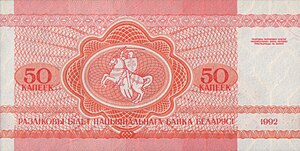
|
50 cop | 105 × 53 mm | Orange-pink | Image of sciurus | Pahonia ("The Chase") | 25 May 1992 | 1 January 2001 | 31 December 2000 | |

|

|
Rbl 1 | Grey blue | Image of the running European hare or "zaichik" which earned the currency its nickname | ||||||
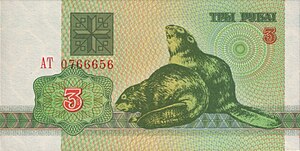
|

|
Rbls 3 | Green | Image of beavers | ||||||

|

|
Rbls 5 | Blue and pink | Image of wolves | ||||||
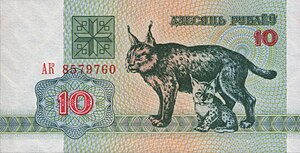
|
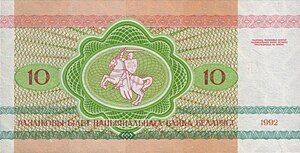
|
Rbls 10 | Dark green | Image of the Eurasian lynx with kitten | ||||||

|

|
Rbls 25 | Orange | Image of moose | ||||||

|

|
Rbls 50 | Violet | Image of brown bear | ||||||

|

|
Rbls 100 | Green-brown | Image of wisent | ||||||

|

|
Rbls 200 | Yellow-green | Image of the train station square | 8 December 1992 | |||||

|

|
Rbls 500 | Violet-red | Victory Square, Minsk | ||||||

|

|
Rbls 1,000 | Green | National Academy of Sciences of Belarus in Minsk | 3 November 1993 | 31 December 2003 | ||||

|

|
Rbls 1,000 | 110 × 60 mm | Large image of the number 1,000 | 16 September 1998 | |||||

|

|
Rbls 5,000 | 105 × 60 mm | Red | Trinity Hill in Minsk | Pahonia | 7 April 1994 | |||
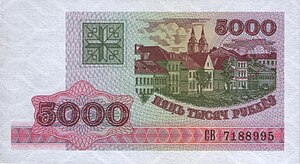
|

|
Rbls 5,000 | 110 × 60 mm | Large image of the number 5,000 | 16 September 1998 | |||||

|

|
Rbls 20,000 | 150 × 69 mm | Olive-yellow | National Bank of the Republic of Belarus | Pahonia | 28 December 1994 | |||

|

|
Rbls 50,000 | Light brown | Kholm Gate | Brest Fortress Memorial | 15 September 1995 | ||||

|

|
Rbls 100,000 | Grey-brown | Opera and Ballet Theatre (Minsk) | Scene from the ballet "Favourite" («Избранница») by E.A. Hlebau | 17 October 1996 | ||||

|

|
Rbls 500,000 | Orange-red | The Republican Trade Unions' Palace of Culture in Minsk | Architectural decorations on the Republican Palace of Culture of Belarus | 1 December 1998 | ||||

|

|
Rbls 1,000,000 | Sky-blue | The National Museum of Arts of Belarus in Minsk | Fragment of the picture "Portrait of wife with flowers and fruits" by I. Khrutski | 30 April 1999 | ||||
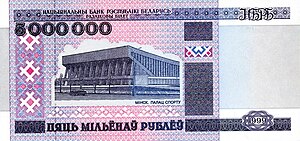
|

|
Rbls 5,000,000 | Light violet | Minsk Sports Palace | Image of the "Raubichy" sports complex | 6 September 1999 | ||||
Second ruble (BYR)
In 2000, notes were introduced in denominations of 1, 5, 10, 20, 50, 100, 500, 1,000, and 5,000 rubles (BYR), with 1 BYR = 1,000 BYB (first ruble). In 2001, higher denominations of 10,000, 20,000, and 50,000 rubles were introduced, followed by 100,000 rubles in 2005 and 200,000 rubles in 2012. There were no coins or banknotes issued in copecks.
"On 1 September 2010, new rules of Belarusian orthography came into force. According to the old rules, the correct spelling of the word “fifty” in Belarusian was “пяцьдзесят,” (pyats'dzesyat) but under the new rules, it should be spelled “пяцьдзясят,” (pyats'dzyasyat) the difference being that the seventh character was the Cyrillic letter YE but is now the Cyrillic letter YA. As a result of these new rules, the existing 50 and 50,000 ruble notes dated 2000 now technically contain errors where the denominations are spelled out on the notes. On 29 December 2010, the National Bank of Belarus introduced new 50- and 50,000-ruble banknotes to bring the inscriptions on the notes into compliance with the new rules of Belarusian spelling and punctuation. The images, colors, and sizes of the notes remain consistent with the preceding issues of the same denominations dated 2000. The modified 50 ruble notes also no longer has a security thread, and the modified 50,000 ruble notes have replaced the solid security thread for a 2mm-wide windowed security thread."[15]
| 2000 Series [14] | |||||||||
|---|---|---|---|---|---|---|---|---|---|
| Image | Value | Dimensions | Main Color | Description | Date of | ||||
| Obverse | Reverse | Obverse | Reverse | issue | withdrawal | lapse | |||

|

|
Rbl 1 | 110 × 60 mm | Green | The building of the National Academy of Sciences of Belarus | Denomination in figures | 1 January 2000 | 1 January 2003 | 31 December 2003 |

|

|
Rbls 5 | Rose-red | View of the Trayetskaye Pradmyestsye in Minsk | 1 September 2004 | 30 June 2005 | |||

|

|
Rbls 10 | Light blue | The building of the National Library of Belarus | 1 March 2013 | 31 March 2014 | |||

|

|
Rbls 20 | 150 × 69 mm | Olive-yellow | The building of the National Bank of Belarus | The interior of the building of the National Bank of Belarus | |||

|

|
Rbls 50 | Orange-red | The Kholm Gate - fragment of the Memorial Brest Hero-Fortress | The main entrance to the Memorial Brest Hero-Fortress | 1 July 2015 | 1 July 2016 | ||

|

|
Rbls 100 | Green | The National Academic Great Opera and Ballet House of Belarus in Minsk | Scene from ballet "Favourite" by E.A. Hlebau | 1 January 2017 | 1 January 2022 | ||
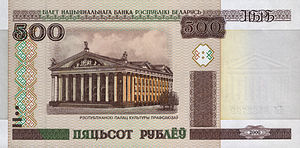
|

|
Rbls 500 | 150 × 74 mm | Light brown | The Republican Trade Unions' Palace of Culture in Minsk | Architectural decorations on the Republican Palace of Culture of Belarus | |||

|

|
Rbls 1,000 | Light blue | The National Museum of Arts of Belarus in Minsk | Fragment of the picture "Portrait of the wife with flowers and fruits" by I. Khrutski | ||||

|

|
Rbls 5,000 | Light violet | Minsk Sports Palace | Image of the "Raubichy" sporting complex | ||||

|

|
Rbls 10,000 | Pink | Panorama of Vitebsk city | Summer amphitheatre in Vitebsk | 16 April 2001 | |||

|

|
Rbls 20,000 | Grey | Gomel Palace | A view of the palace from A. Idzkouski's picture in Homyel | 21 January 2002 | |||

|

|
Rbls 50,000 | Sky blue | A castle in the settlement of Mir, Karelichy district, Grodno Region | Decorative collage of architectural elements of Mir Castle | 20 December 2002 | |||

|

|
Rbls 100,000 | Orange | The Nesvizh Castle | View of the Radziwills' Castle in Niasvizh from a painting by the Belarusian artist Napoleon Orda | 15 July 2005 | |||

|

|
Rbls 200,000 | Light green | The Mogilev Maslennikov Art Museum | Decorative collage of architectural elements of the museum building | 12 March 2012 | |||
Third ruble (BYN)
In 2016, banknotes were introduced in denominations of 5-, 10-, 20-, 50-, 100-, 200-, and 500 rubles (BYN), with 1 BYN = 10,000 BYR (second ruble). On 4 November 2015, the National Bank of the Republic of Belarus announced that the banknotes that had been in use at that time would be replaced by the new ones due to the upcoming redenomination.[13] The redenomination would be made in a ratio of 1:10,000 (10,000 rubles of the 2000 series = 1 ruble of the 2009 series). This currency reform also brought the introduction of coins, for the first time in The Republic of Belarus.[16]
The banknotes are printed by the United Kingdom-based banknote manufacturer, security printing, paper-making and cash handling systems company De La Rue. As for coins, they have been minted by both the Lithuanian Mint and the Kremnica Mint.[17] Both banknotes and coins have been ready in 2009, but the financial crisis prevented them from being put into circulation immediately, resulting in a 7-year delay conditional on the necessity to lower inflation. Their designs are very similar to the euro banknotes.
| 2009 Series [18] | ||||||||||
|---|---|---|---|---|---|---|---|---|---|---|
| Image | Value | Dimensions | Main Color | Description | Date of | |||||
| Obverse | Reverse | Obverse | Reverse | printing | issue | withdrawal | lapse | |||

|

|
Rbls 5 | 135 × 72 mm | Orange | Belaya Vezha in Kamyanyets | collage on the theme of the first Slavic settlements | 2009 2019 2020 2022 (5, 10, 20, 50 and 100 ruble banknotes) |
1 July 2016 | Current | Current |

|

|
Rbls 10 | 139 × 72 mm | Light Blue | Transfiguration Church in Polatsk | collage on the theme of enlightenment and printing | ||||

|

|
Rbls 20 | 143 × 72 mm | Yellow | Rumyantsev-Paskevich Residence in Homyel | collage on the theme of spirituality | ||||

|

|
Rbls 50 | 147 × 72 mm | Green | Mir Castle in Mir | collage on the theme of art | ||||
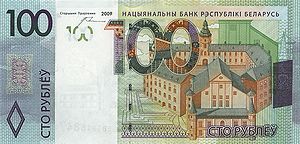
|

|
Rbls 100 | 151 × 72 mm | Turquoise | Niasvizh Castle in Nesvizh | collage on the theme of theater and folk holidays | ||||

|

|
Rbls 200 | 155 × 72 mm | Violet | Regional Museum of Art in Mahilyow | collage on the theme of crafts and town-planning | ||||

|

|
Rbls 500 | 159 × 72 mm | Pink and Blue | The building of the National Library of Belarus in Minsk | collage on the theme of literature | ||||
Exchange rates


On 2 January 2009, the National Bank of the Republic of Belarus lowered the exchange rate of the ruble by 50%.
On 24 May 2011, the National Bank of the Republic of Belarus lowered the exchange rate of the ruble by 56%.[19] Alexei Moiseev, chief economist at Russia's VTB Capital, said at the time that "a '91-style meltdown is almost inevitable", referring to the crisis which accompanied the dissolution of the Soviet Union.[20]
On 20 October 2011, the exchange rate of the ruble dropped 42% (from Rbl 5,712 to Rbl 8,680 per US$) when it was fully floated following demands to do so by Russia and the IMF.[21]
In January 2015, the National Bank of the Republic of Belarus devalued its currency by 23% against the US dollar despite efforts to keep Russia's currency crisis from spreading across the border. As of 1 February, one U.S. dollar was worth Rbls 15,400; by Tuesday, it fell to Rbls 15,450 to the dollar, as per data from the Belarusian Central Bank's website.[22]
As of mid-March 2022, the Belarusian ruble had reached an all-time low of Rbls 3.33 per US$1, during fallout from the 2022 Russian invasion of Ukraine. On 1 April 2022, it traded at Rbls 3.26 per US$, and had lost 21.5% of its value year-to-date.[23] From 15 July 2022 to 1 October 2023 the currency was fixed at the rate of 2.5 in order to pay debts; since then its value remains fixed at 3.27
| Current BYN exchange rates | |
|---|---|
| From Google Finance: | AUD CAD CHF CNY EUR GBP HKD JPY USD RUB |
| From Yahoo! Finance: | AUD CAD CHF CNY EUR GBP HKD JPY USD RUB |
| From XE.com: | AUD CAD CHF CNY EUR GBP HKD JPY USD RUB |
| From OANDA: | AUD CAD CHF CNY EUR GBP HKD JPY USD RUB |
See also
References
Notes
Sources
- ^ "World Bank Editorial Style Guide 2020 - page 134" (PDF). openknowledge.worldbank.org. Retrieved 2022-09-03.
- ^ "Coins Put into Circulation by the National Bank of the Republic of Belarus | National Bank of the Republic of Belarus". www.nbrb.by. Retrieved 2019-07-23.
- ^ CURRENCY BELARUS MARKET: MAIN TRENDS AND CHALLENGES
- ^ "Belarus". United States Department of State. Retrieved 2024-12-22.
- ^ "Belarus central bank to remove euro from currency basket weightings". euronews. 2022-12-08. Retrieved 2024-12-22.
- ^ "Расследование «КП»: белорусского «зайчика» списали из детской книжки!" [“KP” investigation: the Belarusian “bunny” was copied from a children’s book!] (in Russian). Archived from the original on 2016-01-24.
- ^ a b c National Bank of the Republic of Belarus. "NBRB banknotes". Retrieved 2006-12-30.
- ^ a b c "Belarus to link currency to dollar". Associated Press. 2007-08-15. Archived from the original on April 22, 2008. Retrieved 2007-10-01.
- ^ "Will rouble become Belarus currency?". Pravda.ru. 2003-12-02. Archived from the original on 2007-09-29. Retrieved 2007-10-01.
- ^ Belarus new redenominated notes (B137 - B143) reported for 01.07.2016 introduction Archived 2015-12-08 at the Wayback Machine BanknoteNews.com November 5, 2015. Retrieved on 2015-11-05.
- ^ On redenomination of the Belarusian ruble since July 1, 2016 National Bank of the Republic of Belarus (nbrb.by). Retrieved on 2015-11-05.
- ^ "Banknotes and Coins of the National Bank of the Republic of Belarus". National Bank of the Republic of Belarus. Retrieved 2012-06-15.
- ^ a b "О проведении с 1 июля 2016 г. деноминации белорусского рубля | Национальный банк Республики Беларусь | Национальный банк Республики Беларусь". Archived from the original on 2016-07-13. Retrieved 2016-07-01. О проведении с 1 июля 2016 г. деноминации белорусского рубля
- ^ a b "Banknotes of the National Bank of the Republic of Belarus Out of Circulation". National Bank of the Republic of Belarus.
- ^ Linzmayer, Owen (2011). "Belarus". The Banknote Book. San Francisco, CA: BanknoteNews.com. Retrieved 2011-08-21.
- ^ "Новости: Деноминация в Беларуси: что изменится с приходом "новых" денег?". Archived from the original on 2018-09-05. Retrieved 2015-12-29.
- ^ "Новые деньги". 10 November 2015.
- ^ "Banknotes of the National Bank of the Republic of Belarus in Circulation". National Bank of the Republic of Belarus.
- ^ "Panic ensues amongst Belarus residents after 56% devaluation of national currency". Baltic News Network. May 24, 2011. Retrieved August 15, 2011.
- ^ "Belarus faces an economic precipice". The World from PRX. 2016-08-02. Retrieved 2024-12-22.
- ^ "Belarus ruble sinks 34% in full free float - FRANCE 24". Archived from the original on 2011-10-21. Retrieved 2012-07-17.
- ^ "Belarusian Ruble Drops 20% Against Dollar in January". The Moscow Times. February 3, 2015. Retrieved August 9, 2015.
- ^ "Belarusian Ruble Exchange Rate (USD to BYR) - News & Forecasts". FocusEconomics | Economic Forecasts from the World's Leading Economists. 18 December 2023.
External links
- National bank of the Republic of Belarus - Official Exchange Rates (English)
- Information about Belarusian commemorative coins (English)
- Catalog of Belarus Banknotes Archived 2015-07-22 at the Wayback Machine
- LIVE Belarus Ruble eXchange Rates : BYR (English)
- Coins of Belarus at CISCoins.net
- Complete Gallery of Belarus Banknotes (issued and unissued)
- ^ Belarus - a Strong Nation for the 21st Century, Jessop and Bridgot, 2017 Oxford Press, pp. 15, 17, 28, 29, 33, 42, 163, 285, 386.


